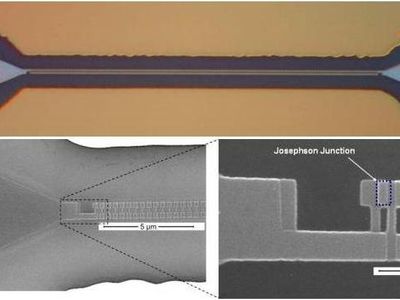Basic quantum transport theory: Landauer's formula and Landauer-Biittiker's formalism, coulomb-blocked and single-electron circuits. Basic superconducting electronics: The Josephson effect and classical non-linear dynamics of superconducting circuits. Quantum electrodynamics of superconducting circuits and superconducting quantum bits. Hybrid quantum systems such as quantum optomechanics and quantum acoustics.
SK2906 Quantum Circuits 7.5 credits

This course covers some basic concepts in quantum electrical circuits. We start with a review of circuits and how lumped-element approximations relate to continuum electrodynamics. We also introduce superconductivity and the Josephson effects, leading to nonlinear Josephson inductance and the related phenomena of kinetic inductance. We study the classical nonlinear circuit dynamics of Josephson circuits which have characteristic frequencies in the microwave region. We then shift to the quantum treatment of these nonlinear circuits, deriving their energy spectrum, and describing how they are designed for use as quantum bits (qubits). The challanges of realising a quantum computer with superconducing techoology will be discussed. Finally, we study the quantum limits of signal amplficiation, and electromechanical circuits that measure mechanical modes, such as vibrating plates or beam at the quantum mechanical limit.
Information per course offering
Information for Autumn 2026 Start 26 Oct 2026 programme students
- Course location
AlbaNova
- Duration
- 26 Oct 2026 - 11 Jan 2027
- Periods
Autumn 2026: P2 (7.5 hp)
- Pace of study
50%
- Application code
51029
- Form of study
Normal Daytime
- Language of instruction
English
- Course memo
- Course memo is not published
- Number of places
Places are not limited
- Target group
- TTFYM
- Planned modular schedule
- [object Object]
- Schedule
Contact
Course syllabus as PDF
Please note: all information from the Course syllabus is available on this page in an accessible format.
Course syllabus SK2906 (Spring 2022–)Content and learning outcomes
Course contents
Intended learning outcomes
After finished course the student should be able to:
- apply basic theories of quantum transport
- formulate and analyze lumped-element model for quantum circuits
- explain basic concepts of quantum-limited measurement
Literature and preparations
Specific prerequisites
English B / English 6
Completed course SI1146 Vector analysis and Sl1155 Theoretical physics.
Literature
Examination and completion
Grading scale
Examination
- INL1 - Homework Problems, 7.5 credits, grading scale: A, B, C, D, E, FX, F
Based on recommendation from KTH’s coordinator for disabilities, the examiner will decide how to adapt an examination for students with documented disability.
The examiner may apply another examination format when re-examining individual students.
If the course is discontinued, students may request to be examined during the following two academic years.
Examiner
Ethical approach
- All members of a group are responsible for the group's work.
- In any assessment, every student shall honestly disclose any help received and sources used.
- In an oral assessment, every student shall be able to present and answer questions about the entire assignment and solution.